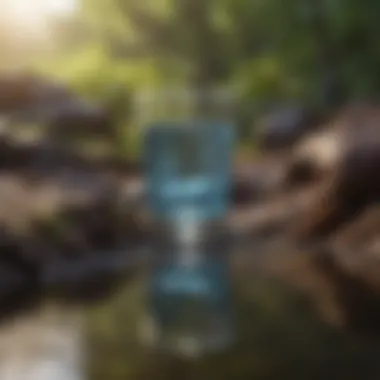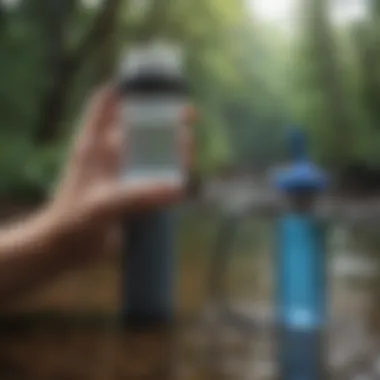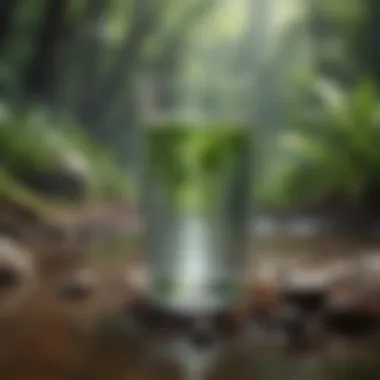Creating an Emergency Water Filter: A Guide for Kids


Intro
Clean water is essential for humans and the planet. Teaching kids about water purification in survival situations balances their understanding of science with practical skills. This guide explores the steps to create an emergency water filter, engage children, and spark interest in environmental conservation.
Nature Topic Overview
Water is vital for life, whether for drinking, bathing, or agriculture. Understanding how to filter water helps kids grasp the importance of clean sources and decision-making in emergencies. This exploration shows how simple materials can purify water, making it safe for consumption. This knowledge fosters respect for this invaluable resource.
Fun Facts and Trivia
Did you know that about 71% of Earth’s surface is covered by water? Yet, only a small percentage is drinkable.
- The average person needs about two to four liters of water daily to stay healthy.
- Water is the only substance that can exist in three states: solid, liquid, and gas.
Visuals can enhance understanding. Show kids images of various water bodies or filtered vs. unfiltered water. They engage directly, reinforcing learning through visual cues.
Wildlife Explorations
Many animals rely on clean water. Fish need it for survival, while birds depend on water for nesting. Explore:
- Turtles: They thrive in clean lakes, highlighting the interconnected boon of water cleanliness.
- Beavers: Building dams creates habitats, but water quality is crucial for their ecosystem.
To gain deeper knowledge, introduce interactive quizzes or puzzles about these animals suited for nature lovers.
Environmental Awareness
Conservation must begin early. Every action counts in preserving water. Here are some tips for children:
- Always use water efficiently.
- Report pollution in nearby streams or lakes.
- Participate in clean-up days to help maintain local water sources.
Encouraging responsible actions instills awareness and emphasizes collective efforts against pollution.
DIY Nature Activities
Kids learn better through hands-on activities. How about these ideas?
- Build a Simple Water Filter: Follow guided steps and use common materials like sand, grit, and charcoal.
- Outdoor Exploration: Encourage them to visit a local water body and observe what lives there.
- Craft Projects: Create art from found objects in the environment.
In showcasing how filtration works, incorporate art, science, and the joy of nature!
Clean water is not just a personal responsibility; it is a collective lifestyle choice for our future.
Understanding the Importance of Clean Water
Water is vital for all living things. It sustains life and supports our health. Having access to clean water is not just a convenience. It's essential for survival. This article focuses on why understanding clean water is so important, especially in an emergency situation.
Why Water Quality Matters
Clean water is crucial for many reasons. Firstly, it directly affects our health. Unsafe water can lead to diseases like cholera and dysentery. These conditions are often caused by germs and pollutants found in contaminated water.
Moreover, good water quality has benefits that go beyond health. It can positively impact the environment and promote biodiversity. Healthy ecosystems depend on clean water. Protecting water sources equals protecting our planet.
To learn more about health and water, check resources at Britannica.
Common Water Contaminants
Knowing the types of water contaminants helps in understanding water safety. Contaminants can originate from various sources, which include:
- Bacteria: Tiny organisms that can cause severe infections.
- Viruses: Another kind of germ. Examples include Hepatitis A, which spreads through dirty water.
- Chemicals: These can come from pesticides or industrial waste. They can be harmful, sometimes at very low levels.
- Heavy Metals: Elements like lead and mercury can enter water from old pipes or industry.
Recognizing these contaminants can improve awareness on what can affect water quality adversely. It's essential not just for you, but for future generations as well.


The need for clean water must not be underestimated. Lack of access creates problems such as famine and health issues back home.
Be mindful of our water sources. Keeping them clean plays a crucial role for us and all living beings.
Emergency Water Filtration: An Overview
When it comes to ensuring access to clean water, emergency water filtration becomes a crucial skill. In situations where safe drinking water is unavailable, knowing how to construct a water filter from basic materials can be life-saving. This overview seeks to clarify the concept of emergency water filtration, as well as the importance of being prepared for any scenario that may arise.
What is Emergency Water Filtration?
Emergency water filtration involves using various methods and materials to remove contaminants from water, making it safe for consumption. Unlike regular water treatment processes that are often designed for ongoing usage, emergency filtration is more about immediate needs and improvisation.
The fundamental goal of emergency water filtration is to achieve clarity and safety of water quickly. This process can utilize things found at home or in nature. The basic understanding of how these methods work empowers both children and adults during critical situations. Let us dive into the components typically included in a simple emergency water filter as we explore more.
Situations Requiring Emergency Filters
Various occurrences may necessitate the use of an emergency water filter. It's important to discuss these situations so children can grasp the significance of their ability to purify water. Some common scenarios include:
- Natural Disasters: Events like hurricanes, floods, or earthquakes can disrupt normal water supplies or contamination risk.
- Power Outages: Without power, many water purification systems fail, making manual filtration necessary.
- Camping or Hiking Contexts: When engaging in outdoor activities, access to clean water may be limited, especially without good preparation.
- Traveling in Foreign Areas: Environments where the water quality is questionable can lead to illness if proper filtration is not conducted first.
Understanding when to use emergency filters helps prepare for safe and effective water collection and purification.
Encouraging awareness of these various conditions empowers children to appreciate the role that water purification plays. It also allows them to learn how to handle unexpected situations appropriately. By knowing how and when to implement emergency filtration, they are better equipped to act Responsibly and confidently.
Materials Needed for the Filter
Creating an emergency water filter involves precise materials that enhance the effectiveness of the purification process. These materials can be easily sourced, making the task approachable for children and educational for any helper. It is important to understand not only what is needed but also why each component plays a crucial role in water purification.
Common Household Items
Several common household items serve as vital components in building an emergency water filter. These materials often reside unnoticed in kitchens or garages, illustrating the concept of resourcefulness for children. By utilizing everyday items, kids gain practical experiences in upcycling and sustainability.
Here are some examples of household items:
- Plastic bottle: A typical two-liter or one-liter bottle serves as the container for the filter.
- Coffee filter or a piece of fabric: This filters out larger particles.
- Rubber band or string: These items keep the fabric or filter securely attached to the bottle's opening.
Utilizing these materials emphasizes innovation. It highlights the ability to create critical tools out of once-forgotten items around the home. Furthermore, familiarity with these items enhances not only hands-on skills but also problem-solving capabilities in modifying strategies as needed based on available resources.
Natural Filtration Materials
In nature, various materials contribute to the filtration process. This section focuses on materials which children can also find outdoors, offering a direct connection to their environment. The application of natural materials promotes environmental awareness and an appreciation for nature's own filtration systems.
Important natural materials include:
- Sand: Pulling from rivers or beach areas, sand acts as an effective layer of filtration. Its size and texture help obstruct contaminants.
- Gravel: The use of gravel, which can often be found in gardens, supports drainage and provides stability to other filtration layers.
- Activated Charcoal: Although less common at first in households, activated charcoal can often be found in aquarium stores or health product retailers. It effectively absorbs impurities and odors.
Natural materials demonstrate how ecosystems work hard to filter water. Teaching what surrounds kids can motivate them to utilize their environment ethically.
Collecting these materials inspires exploration while creating an awareness of their surroundings. Encouraging children to gather eco-friendly resources fosters a hands-on approach that strengthens bonds with nature.
In summary, these materials—both sourced from household items and nature—are critical. They provide a foundation for understanding how water filtration works, preparing kids for potential real-life applications. Each component directly contributes to ensuring the purity of drinking water when typical sources may become compromised.
Step-by-Step Instructions to Build the Filter
Understanding how to make an emergency water filter is crucial for everyone, especially children. This section provides clear, practical guidance that allows kids to actively engage with the concepts of filtration and water safety. By breaking down the process into manageable steps, young readers can gain confidence and experience in creating something useful. This hands-on approach not only teaches vital survival skills, it fosters curiosity and encourages environmental responsibility.
Preparing the Container
Before building the filter, let’s focus on the container. This vessel will hold all the filtration materials and collected water. It can be made of various materials, but it needs to be sturdy and safe. Common choices include empty plastic bottles or jars. Ensure any container used is clean. Any contaminants in the container could compromise the water filtering process. A well-prepared container sets a solid foundation for the filter’s performance.
Layering the Filtration Materials


In this part, we will talk about the components used to filter the water. Each material plays a specific role, working together to purify water effectively.
Gravel
Gravel is the coarsest material in our filter. It has a significant role in the initial filtering process. Thanks to its uneven surfaces and size, gravel can catch and hold larger particles, like dirt or debris. This is crucial because it prevents finer materials from clogging up the filter too quickly.
A key characteristic of gravel is its accessibility. Most people can find gravel naturally outdoors or at construction sites. Using gravel also allows it to easily capture heavy sediment that can be harmful. So, it becomes a practical, beneficial choice in building an emergency water filter. However, if too fine of a material is chosen, it may not allow water to flow adequately.
Sand
Sand serves as the next layer of filtration and plays an equally vital role. It is finer than gravel and can catch smaller particles and toxins that gravel might miss. This is an important aspect since clearer water lets silt and other particles settle away.
What makes sand special is its high availability and cost-effectiveness. Its light texture allows water to move through while still filtering. Sand can effectively trap smaller bacteria, presenting it as a reliable choice in this context. However, sand must be clean and free from additional contaminants before use to ensure it does not release any impurities into the filtered water.
Activated Charcoal
Activated charcoal is often the star of any filtration system. This material has a lot of tiny pores, making it very effective at adsorbing toxins, chemicals, and even unpleasant tastes or odors from water. In simpler terms, it improves the overall quality of the water significantly.
The unique feature of activated charcoal is its surface area. This characteristic gives it a remarkable ability to filter out many harmful substances. Including activated charcoal makes the filter more efficient, greatly enhancing its performance. Nevertheless, one must use food-grade activated charcoal for safest results. Regular bits of charcoal used for barbecues can release dangerous substances into the water.
Final Assembly Process
Now, let’s get everything together to complete the emergency water filter. Start by placing the layers of gravel, sand, and activated charcoal in order within the container you’ve prepared. Ensure that there’s enough of each material to create an effective barrier.
First, add an inch or so of gravel at the bottom, then a slightly thicker layer of sand above it. Topping it off with a layer of activated charcoal should make for a productive filter.
For stability, shake the container gently after assembling to even out the materials but try to not disturb the layers too much. This step is critical for getting the best results for your filter later on. Place your filter over an additional clean container when filtering water to keep the process neat.
The creative construction of your emergency water filter not only emphasizes practical life skills but also reflects a greater understanding of the water cycle and how natural science works around us.
Testing Your Filter
Testing your water filter is a crucial step that determines its effectiveness at producing clean drinking water. Creatting a reliable filter helps kids understand practical applications of science and highlights the importance of safe water. Efective tests ensure that the water being consumed is safe, which is especially important in emergencies. Right evaluations promote critical thinking, encouraging childen to ask questions as they monitor their process.
How to Collect Water Samples
Gathering water samples is an important task. Young learners must approach this carefully. Start by obtaining a clean container, such as a bottle or jar. Make sure it is free from any residues. Then, choose your water source cautiously. Avoid murky or contaminated areas. Here are steps to collect a water sample safely:
- Hold the container. Make sure it's right-side up to prevent unwanted particles from entering.
- Submerge the container perfectly. This helps in capturing a representative sample.
- Ensure no splashes land back in. Care pays off in getting an accurate sample.
- Seal the container tightly. You want to prevent contamination during transport.
Evaluating Water Quality
After collecting water samples, it's important to evaluate their quality. This involves checking for visible impurities and odor. Kids should remember that crystal clear water does not necessarily mean it's safe. Here are some pointers to evaluate:
- Look for Color and Clarity. Clean water should be clear without any floating objects or discoloration.
- Smell Your Sample. If you detect any strong or unusual odors, this can indicate contamination.
- Taste a small amount, but with caution. Only do this when it is safe, and ideally under advisement. Humans have a good natural instinct for determining when things may be off.
To summarize, testing your filter properly is essential. The collected water sample can provide insights into its current effectiveness in making drinking water safer. These tasks create an educational yet practical experience for K-12 children. Combining science and hands-on activity improves their understanding of water filtration and environmental stewardship.
Safety Considerations
Understanding the safety aspects of creating an emergency water filter is essential, especially aimed at younger audiences. The goal is not just to make a functional filter but to do so in a way that is safe and responsible. Risk management can reduce potential dangers during the filtration process. Teaching children the importance of these safety considerations provides a valuable lesson not only in water filtration but also in taking preventive steps in various life situations.
What Not to Filter
When dealing with water filtration, it is crucial to recognize that not all water sources are suitable for this method. Here are some key points to help understand what should never be filtered:
- Saltwater: This type of water cannot be purified effectively with standard filtration methods. Ingesting saltwater can be harmful as it contains high levels of salinity.
- Chemically Contaminated Water: Water that carries harmful chemicals, such as road runoff or industrial waste, should never be filtered. This water may need specialized treatment unavailable in simple filtration.
- Standing Water: Water that sits stagnant, like that in puddles, can host dangerous pathogens. It may contain harmful bacteria and insects.
Remember this general principle: if the water looks suspicious or smells bad, it's likely best not to attempt filtering it.
Maintaining Cleanliness


Maintaining cleanliness throughout the filtration process promotes both efficiency and safety. Here are important practices to follow:
- Wash Hands: Before collecting or handling any materials for the filter, wash hands thoroughly. This reduces germs and minimizes risk.
- Use Clean Containers: Ensure that all containers used for both collecting water and any part of the filtration process are clean to avoid introducing contaminants.
- Store Materials Properly: Filtration materials like sand and charcoal should be stored in a clean, dry place. This ensures they remain uncontaminated until use.
- Perform Regular Checks: After using the filter, check all equipment for cleanliness and replace any materials that appear dirty or used up.
"> Cleanliness is key to having safe, purified water. Always check your equipment and your hands."
By enforcing your children's understanding of these safety procedures, they will gain practical knowledge crucial in everyday life. These lessons go beyond water filtration and can instill broader habits of cleanliness and care in various scenarios.
Educational Insights
Understanding scenarios where clean water is vital is crucial for children, especially during emergencies. The ability to filter water is not merely a survival skill but also an educational journey promoting awareness of our environment. Engaging in practical exercises teaches kids about ecosystems and not just the immediate benefits of clean drinking water.
Exposure to filtering methods enhances problem-solving skills and creativity. Kids learn to think critically as they decide which materials to use and how to construct their filter. This can enhance their understanding of science concepts, fostering deeper interest in subjects like biology and environmental studies.
By embarking on this learning adventure, children foster a sense of responsibility towards nature and their health.
Another advantage of this educational aspect is promoting teamwork. Kids can collaborate on discussions, helping each other understand better while working towards a common goal. Such group activities not only build friendships but also develop essential interpersonal skills.
This section of the article enlightens them on topics they can explore further, like the significant phenomenon known as the water cycle. The water cycle elucidates the pathways through which water travels across the planet and its importance in maintaining life.
Learning About the Water Cycle
The water cycle illuminates how water turns from liquid to vapor, reshapes landscapes, and finally returns to rivers and oceans. This process is vital to understand as it emphasizes the significance of conserving water. Children trained about the ins and outs of the water cycle get a better base for appreciating water's health benefits.
Here’s a simple breakdown of the stages involved in the water cycle:
- Evaporation: Water from the ground heats and turns into vapor.
- Condensation: The vapor cools down to form clouds.
- Precipitation: Water falls down as rain or snow, filling lakes and rivers.
- Collection: Water accumulates in various forms in our environment, ready to start the cycle again.
Understanding where our water comes from helps in grasping its importance. With this knowledge, next generations can advocate for clean water access and preservation.
The Role of Filtration in Nature
Nature, too, has its own way of filtering water. Wetlands, soil layers, and even rocks operate as natural filters, cleansing water as it moves through various terrains. This minimization snakes its way into streams and rivers, providing clean water to many ecosystems. Recognizing nature as a resource underlines how important it is to keep our environments safe from pollution.
Children observing nature's filtration can draw parallels to their own projects. Creating a water filter at home invokes both admiration and respect for the wild world around them. Here, simple insights unfold:
- Soil Filtration: Different soil layers sift heavier particles and harmful chemicals naturally.
- Wetlands: These serve as natural filters, cleansing water effectively by trapping and breaking down pollutants.
Encouraging youngsters to see the parallels between their homemade filters and nature advances their understanding. Such learning lays the foundation for instilling responsible behavior towards the environment for future caretakers.
In summary, encapsulating lessons about the water cycle and nature's filtering mechanisms entices youngsters to connect water necessity with thoughtful protection.
Closure
A reliable emergency water filter can be vital in crises. Clean water significantly contributes to health and survival. When kids engage in making their filters, it sets a sense of preparedness. The skills they learn are not just a tool for survival, they can foster resilience.
The Importance of Preparedness
Preparedness is the foundation of safety in any unexpected situation. Teaching children how to create a water filter prepares them for emergencies. Knowing this knowledge can empower them. It transforms kids from passive observers into active participants. When children learn what to do in difficult scenarios, they gain confidence. This experience is crucial as they grow.
In a practical setting, developing this filter gives kids skills for life. They can understand the risks of improper water and the techniques to handle them. Also, it seems complex at first, but it simplifies survival skills, making them grasp these methods better.
Beyond just making a filter, it sparks that intrinsic curiosity. Kids begin to inquire deeper into environmental issues. They learn relationships in nature’s cycles and develop critical problem-solving skills.
Encouraging Further Exploration
Additional exploration is key in forming lifelong learners. After creating a water filter, it leads a child to think about water sources around them. Questions may arise about how rivers or lakes impact our health. These questions can initiate discussions and even lead to experiments.
Encouraging further digging leads to several areas of learning:
- Understanding the water cycle: Where does water come from and go?
- Investigating local ecosystems: How does natural filtration work?
- Activities relating to water conservation can cultivate stewardship.
Resources like documentaries or local workshops can supplement this passion for knowledge. Hands-on activities, discussions, and scientific aesthetics act as springboards. As kids connect these studies to real life, they will likely appreciate clean water.
It is imperative that we diversify learning while maintaining interest. The quest for knowledge is continuous and can be rewarding.
Children thrive on exploration and experiment. More importantly, encouraging inquisitive behaviors about water ensures they respect its value. It can set the tone for responsible practices in adulthood.







